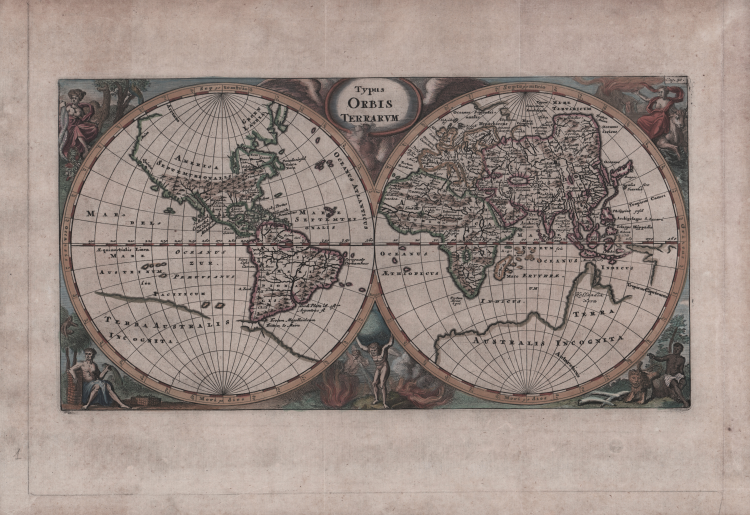- New




| Reference: | S48065 |
| Author | Philipp CLUVER |
| Year: | 1729 |
| Zone: | The World |
| Printed: | Amsterdam |
| Measures: | 305 x 165 mm |



| Reference: | S48065 |
| Author | Philipp CLUVER |
| Year: | 1729 |
| Zone: | The World |
| Printed: | Amsterdam |
| Measures: | 305 x 165 mm |
Interesting double hemisphere map of the world, from Cluver's Introductionis en Universum Geographicus…., one of the most prolific 17th and 18th Century Geography books.
First published in Leiden in 1624, Cluver's popular geographical history describes all the countries of the world, including a section on America and the islands of the ‘New World’, and is fully illustrated with engraved maps. The text includes notes by Johann Buno, Johann Friedrich Heckel and Johann Reiske from earlier editions of the work.
Philipp Clüver (also known as Klüwer, Cluwer or Cluvier, or by the Latinised names Philippus Cluverius and Philippi Cluverii) was an early modern German geographer and historian who made significant contributions to the field of historical geography. Clüver was renowned as an antiquarian and geographer and became known for his general study of the geography of antiquity. His approach combined classical literary sources with empirical knowledge from his extensive travels and local inspections, laying the foundation for the field of historical geography. Clüver is also known for his contributions to mathematical and theological writings and is remembered by cartography enthusiasts for his edition of Ptolemy's Geographia and his miniature atlases.
The map presents a classic depiction of the world as known in the mid-17th Century. Quivira and Anian appear along the northwest coast of America, with Fretum Anian (Straits of Anian) depicted off the coast of northeast Asia, a depiction of the narrow passage believed to separate the continents and lead to the Northwest and Northeast Passages, above each continent. The Northeast Passage is clearly depicted, the Northwest more tentatively so, in recognition of the extensive explorations of the northeast polar regions by Barentsz and successors, versus the relative lack of success by the various explorers in the northern reaches of North America, above the poles (although the open depictions of the western parts of the bays in Nova Francia are reflective of the continued explorations).
In the southern hemisphere, the mythical Terra Australis Incognita dominates the map, with a narrow passage below Java Major and unnamed New Guinea, giving hints of the discovery of the Australian continent. The interior of North America is little known, with no Great Lakes and only a modest depiction of the Mississippi River. The Rio Grande is flowing into the Gulf of California. The bulging depiction of the east coast of North America is reflective of the explorations in the first half of the 17th Century, with Florida, Virginia, Norembega (New England) identified. The depiction of South America remains oversized, with a curious mix of pre-Le Maire and post-Le Maire geography shown at the southern tip of the continent.
Example taken from Introductionis in universam geographiam tam veterem quam novam libri VI. Cum integris Johannis Bunonis, Joh. Frid. Hekelii & Joh. Reiskii, & selectis Londinensibus notis. Amsterdam: Johannes Pauli, 1729.
Etching with fine later hand colour, very good condition.
Bibliografia
Shirley, Mapping of the World, n. 586.
Philipp CLUVER (Danzica 1580 - Leyden 1622)
|
Cluver was born in in Danzig and after studying in Leyden and Oxford, he took interest in historical geography; his subsequent publications made a wide and influential contribution to the knowledge of the subject .
1616-31 Germania Antiqua
1619 Sicilia Antiqua
1659 ,c. 1724 Re-issued
1624 Italia Antiqua
1659,1674,1724 Re-issued
1624 Introductionis in Universam Geographicam
(4to)
1667,1676,1683,1711,1729 and later issues
|
Philipp CLUVER (Danzica 1580 - Leyden 1622)
|
Cluver was born in in Danzig and after studying in Leyden and Oxford, he took interest in historical geography; his subsequent publications made a wide and influential contribution to the knowledge of the subject .
1616-31 Germania Antiqua
1619 Sicilia Antiqua
1659 ,c. 1724 Re-issued
1624 Italia Antiqua
1659,1674,1724 Re-issued
1624 Introductionis in Universam Geographicam
(4to)
1667,1676,1683,1711,1729 and later issues
|